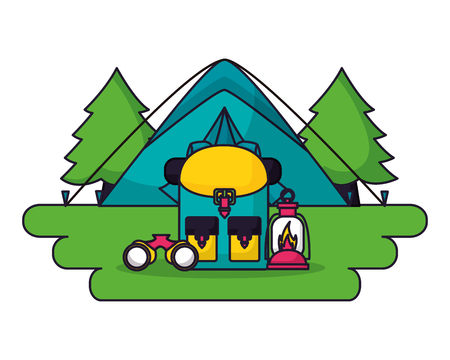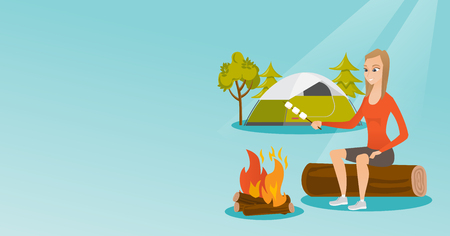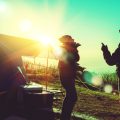1. Choosing the Right Spot at Your Campsite
When youre car camping and planning to set up a DIY outdoor cooking station, the first thing you need to do is choose the right spot. A good location can make your cooking experience safer, more enjoyable, and much easier. Here are some key things to consider:
Wind Direction
Always pay attention to which way the wind is blowing. You want to place your cooking station so that smoke and heat blow away from your campsite and not into your tent or toward where people are sitting. Cooking downwind also helps prevent sparks or flames from reaching flammable areas.
Flat Ground
Choose a flat and stable surface for your cooking setup. This helps prevent pots and pans from tipping over and makes it easier to keep everything organized. Avoid setting up on slopes, loose gravel, or uneven surfaces that could be a tripping hazard.
Distance from Tents and Sleeping Areas
Safety first—your cooking area should be at least 50 feet (15 meters) away from any tents or sleeping zones. This reduces the risk of fire and keeps food smells away from where you sleep, which can help avoid attracting wildlife.
Quick Guide: Picking the Best Spot
| Factor | Why It Matters | What to Look For |
|---|---|---|
| Wind Direction | Keeps smoke out of camp and prevents fire hazards | Set up downwind from tents and common areas |
| Flat Ground | Makes cooking safer and more stable | Look for solid, level terrain without loose rocks |
| Distance from Tents | Avoids fire risks and keeps animals away from sleeping spots | At least 50 feet (15 meters) from tents |
Bonus Tips
- Avoid Tree Cover: While shade is nice, branches can drop debris or catch fire if youre using open flames.
- Check Local Rules: Some campgrounds have specific rules about where you can cook. Always follow posted guidelines.
- Accessibility: Make sure your cooking area is easy to get to from your car so unloading gear is hassle-free.
Selecting the right spot sets the tone for your entire camping kitchen setup. Take a few extra minutes when you arrive at your site to scout out the best location—it’ll pay off with a safer, smoother cooking experience.
2. Essential Materials and Tools You’ll Need
Before you start building your DIY outdoor cooking station for car camping, it’s important to gather the right materials and tools. Luckily, most of what you’ll need is budget-friendly and can be found at major U.S. retailers like Walmart, Home Depot, or online on Amazon. Below is a breakdown of essential items that are both affordable and easy to find.
Basic Building Materials
These form the structure of your cooking station. You can customize based on your vehicle size and how often you camp.
| Item | Description | Where to Find |
|---|---|---|
| Plywood (1/2” or 3/4”) | Main surface or shelves; durable and easy to cut | Home Depot, Lowe’s |
| 2×4 Lumber | Support frame for structure stability | Home Depot, Local Lumber Yards |
| Hinges & Screws | For fold-out parts and basic assembly | Hardware stores, Amazon |
| Drawer Slides (optional) | Helps with pull-out stove or storage sections | Amazon, Rockler |
Cooking Gear Essentials
You don’t need fancy equipment—just the basics that are portable, reliable, and suited for car camping.
| Gear | Description | Recommended Brands/Sources |
|---|---|---|
| Propane Camp Stove (2-burner) | Main heat source for cooking meals outdoors | Coleman, Camp Chef – available at Walmart, REI |
| 5 lb Propane Tank or Green Canisters | Powers your stove; refillable tanks are more eco-friendly | Walmart, Ace Hardware |
| Collapsible Sink Basin | For dishwashing and prepping food with water access | Amazon, REI |
| Water Jug with Spout (5-7 gallons) | Portable clean water supply for washing and cooking | IKEA, Walmart, Amazon Basics |
Tools You’ll Need to Build It Out
If you’re handy or know someone who is, these basic tools will help you build a sturdy setup in no time.
- Cordless Drill/Driver: For driving screws into wood quickly.
- Circular Saw or Jigsaw: To cut plywood and lumber to size.
- Tape Measure & Square: For accurate measuring and straight cuts.
- Sanding Block or Power Sander: To smooth out rough edges.
- Clamps: Helpful when assembling pieces solo.
A Few Optional Extras That Make Life Easier:
- Bungee Cords/Velcro Straps: Keep gear secure during travel.
- S Hooks/Magnetic Strips: Hang utensils or knives for easy access.
- Shelf Liner or Rubber Mat: Prevents items from sliding around while driving.
This list gives you a solid starting point to begin building a custom outdoor kitchen that fits perfectly in your car camping setup without breaking the bank. In the next section, we’ll walk through the step-by-step process of putting it all together.

3. Constructing a Stable Cooking Surface
When youre car camping, having a solid and safe surface for your stove and food prep is essential. You don’t need to invest in expensive gear—there are plenty of DIY options that can get the job done just as well. Let’s look at how to create a stable cooking station using either folding tables or custom wooden setups.
Option 1: Using Folding Tables
Folding tables are one of the easiest and most convenient ways to build a cooking surface. Theyre lightweight, portable, and quick to set up. However, not all folding tables are created equal. Look for ones with sturdy legs and a heat-resistant surface.
Recommended Table Features
| Feature | Why It Matters |
|---|---|
| Sturdy Legs with Locking Mechanism | Prevents wobbling while cooking |
| Heat-Resistant Surface | Safe for placing hot stoves or pots |
| Adjustable Height | Makes it easier to cook comfortably |
| Foldable Design | Makes transport and storage simple |
Option 2: DIY Wood Platform Setup
If you’re handy with tools, building a custom wood platform can be a fun weekend project and give you more flexibility in design. Use treated wood or seal the surface to make it weather-resistant.
Basic Materials Youll Need:
- Plywood board (at least ¾ inch thick)
- 2×4 wood planks for support legs and framing
- Screws or nails
- A drill or hammer
- Wood sealer or outdoor paint (optional but recommended)
Simple Step-by-Step Build Guide:
- Cut your plywood to the desired tabletop size (a good size is around 24” x 48”).
- Create a rectangular frame underneath the plywood using 2x4s to provide support.
- Add legs made from 2x4s at each corner. Make sure they’re all the same length so the table sits level.
- Screw everything together tightly for stability.
- If you want extra durability, add cross-supports between the legs.
- Apply a weatherproof sealant or outdoor paint if you plan to leave it outside overnight.
Pro Tip: Leveling Your Station on Uneven Ground
Campsites aren’t always perfectly flat. Bring along some small wood shims or adjustable leg caps to help level out your cooking surface if needed. A stable setup ensures safety when youre handling hot items.
Optional Add-ons for Convenience:
- Hooks or rails: For hanging utensils or towels.
- Shelf underneath: To store bins, cookware, or food supplies.
- Bungee cords: To secure your stove in windy conditions.
No matter which route you take—store-bought folding table or handmade wooden station—the key is making sure it’s stable, level, and functional for your car camping kitchen needs.
4. Organizing Your Cooking Gear Like a Pro
Once you’ve built your DIY outdoor cooking station, keeping your gear organized is key to stress-free car camping. A well-organized setup saves time, keeps your cooking space clean, and ensures you don’t forget the essentials. Here are some practical storage hacks using crates, hanging organizers, and camping bins to help you stay on top of your cooking game.
Use Stackable Crates for Easy Access
Plastic milk crates or stackable storage bins are perfect for separating and organizing gear. You can dedicate each crate to a specific category—think cookware, dry goods, or cleaning supplies. Label each crate so you can find what you need in seconds.
| Crate | Contents |
|---|---|
| Cooking Tools | Spatula, tongs, knife set, cutting board |
| Pantry Items | Dry pasta, rice, canned goods, snacks |
| Cleaning Supplies | Sponge, soap, trash bags, paper towels |
Add Hanging Organizers for Small Essentials
A hanging shoe organizer or tool roll can be repurposed as a utensil and spice rack. Hang it from your cooking station canopy or the side of your vehicle. This keeps small items off the table and within arm’s reach.
What to Store in a Hanging Organizer:
- Cooking utensils (spoons, ladles)
- Seasonings and spices (salt, pepper, garlic powder)
- Lighters and matches
- Ziplock bags or foil sheets
Use Camping Bins with Compartments
If you prefer something more rugged, invest in heavy-duty camping bins with dividers. These keep fragile items like mugs or spice jars safe during travel. Choose transparent bins if possible so you can see what’s inside without opening them.
Pro Tip:
Keep a small checklist inside each bin lid to remind yourself what belongs where when packing up camp.
Create a “Grab-and-Go” Essentials Kit
This kit should include everything you need for quick meals—think stove fuel, lighter, oil, salt & pepper, and one-pot tools. Store it in a compact tote bag or plastic container that’s always ready to go.
Suggested Items for an Essentials Kit:
- Small bottle of cooking oil
- Lighter or waterproof matches
- Multi-tool or pocket knife
- Your favorite all-purpose spice blend
- Collapsible bowl or plate
An organized cooking station not only looks great but makes camp life easier and more enjoyable. With the right storage solutions and a little planning ahead, you’ll cook like a pro—even in the wild!
5. Safety Tips and Leave No Trace Principles
When setting up your DIY outdoor cooking station for car camping, safety and environmental responsibility should always be top priorities. Whether youre grilling burgers or brewing coffee, following some basic guidelines will help keep you safe and ensure future campers can enjoy the same beautiful spots.
Fire Safety Guidelines
Cooking over an open flame or using a camp stove can be fun, but it also comes with risks. Here are a few fire safety tips to keep in mind:
| Tip | Description |
|---|---|
| Check Fire Restrictions | Always check local fire regulations before lighting any fire or using a stove. Many areas have seasonal bans due to wildfire risk. |
| Create a Safe Zone | Clear at least a 10-foot radius around your cooking area of dry grass, leaves, and debris. |
| Never Leave Flames Unattended | If you need to step away, turn off your stove or fully extinguish the fire. |
| Have Water Nearby | Keep a bucket of water or a fire extinguisher within arm’s reach while cooking. |
Smart Food Management
The way you store and handle food is crucial — not only for your health but also to prevent attracting wildlife.
- Use Bear-Proof Containers: In bear country, store all food and scented items (like toothpaste) in bear-proof containers or lockers when not in use.
- Avoid Leaving Food Out: Even during meal prep, dont leave snacks unattended. Animals can show up fast!
- Clean Up Immediately After Eating: Dispose of scraps properly and wash dishes right away to avoid lingering smells.
- Packing Tip: Use labeled bins to separate raw foods from ready-to-eat items inside your DIY kitchen setup.
Sustainable Cooking Practices
Your outdoor kitchen should work in harmony with nature. Follow these eco-friendly guidelines to minimize your impact:
- No Soap in Streams: Wash dishes at least 200 feet away from lakes and rivers using biodegradable soap.
- Avoid Single-Use Items: Bring reusable plates, utensils, and containers to cut down on trash.
- Packed In = Packed Out: Don’t leave anything behind — even tiny food scraps or peels.
- Bury Waste Properly: If you’re not near facilities, bury organic waste at least 6 inches deep and far from water sources.
The Leave No Trace Seven Principles Snapshot
| # | Principle |
|---|---|
| 1 | Plan Ahead and Prepare |
| 2 | Travel and Camp on Durable Surfaces |
| 3 | Dispose of Waste Properly |
| 4 | Leave What You Find |
| 5 | Minimize Campfire Impact |
| 6 | Respect Wildlife |
| 7 | Be Considerate of Other Visitors |
Your Role as a Camper-Chef Steward
Your DIY outdoor cooking station isn’t just about convenience — it’s also about responsibility. Following these tips helps protect our wild spaces so that everyone can continue to enjoy them for generations to come. So cook smart, stay safe, and leave no trace!


